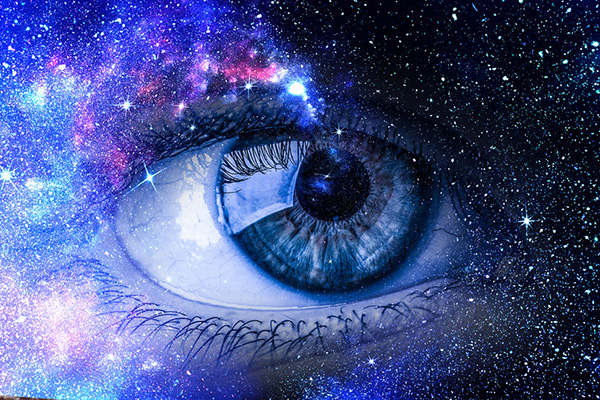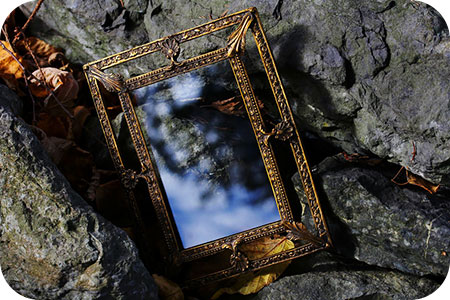mirror
Eye Gazing As A Spiritual Practice
 Eye gazing is a powerful, ancient practice in which two people engage in a shared meditation practice during which eye contact is maintained for an extended period of time. Eye gazing is usually done for about ten minutes at a time, although it can certainly be any duration preferred.
Eye gazing is a powerful, ancient practice in which two people engage in a shared meditation practice during which eye contact is maintained for an extended period of time. Eye gazing is usually done for about ten minutes at a time, although it can certainly be any duration preferred.
Eye gazing can be used to access past life information, promote healing, connect to your higher self, guides, or angels, and almost anything else you can imagine. The eyes are the windows to our soul, and our soul is the singularity that connects us to everything else: the Universe, Source, God, the Divine. Eye gazing is also a profound manifesting tool we can use to further develop our ‘spiritual muscles,’ so to speak.
Before you include eye gazing in your spiritual practice, I recommend you read my previous blog on the essentials of eye gazing. Once you are more familiar with the basics, you can also apply the following guidelines to your eye gazing practice.
To use eye gazing for a specific purpose, you must set a clear intention beforehand, and then hold that intention throughout the gaze. You hold an intention by simply keeping a gentle awareness in the back of your mind that what you are seeing during the gaze is relevant to your intention, and trusting that whatever comes forward is always relevant.
It’s important not to simultaneously hold any expectations about what you’re going to see, or to resist anything that comes up spontaneously, just because you don’t immediately see its relevance or connection to your intention. Keep an open mind and be flexible and accepting in the flow of your gazing experience.
If you’re gazing alone, sit comfortably in front of a mirror, take a few centering breaths, and then state your intention out loud. I prefer to speak aloud in my spiritual practice whenever possible, as words are energy forms and therefore add a ‘weight’ to our prayer requests, intentions, and affirmations. State your intention out loud and ask Spirit to provide insight around this intention. Use language that feels right for you.
Mirror-Touch Synesthesia (MTS)
 Science is catching up with the empath, literally. Recently I came across a fascinating book titles Mirror Touch by Dr. Joel Salinas, a Harvard trained researcher and neurologist at Massachusetts General. It explores the phenomenon of Mirror-touch synesthesia (MTS) – a rare neurological trait that causes someone to feel the emotional and physical experiences of other people.
Science is catching up with the empath, literally. Recently I came across a fascinating book titles Mirror Touch by Dr. Joel Salinas, a Harvard trained researcher and neurologist at Massachusetts General. It explores the phenomenon of Mirror-touch synesthesia (MTS) – a rare neurological trait that causes someone to feel the emotional and physical experiences of other people.
The word synesthesia means joined perception, or to blend the five senses. Science recognizes over 80 types of synesthesia.
Because of Dr. Salinas and other brave professionals, science is sitting up and taking notice and actually exploring the brain and how it functions in individuals with these traits. Dr. Salinas uses his ability of feeling the emotional and physical pain of his patients to treat their symptoms, as if they were his own. The experience for him and others like him is challenging and draining.
The Mystical Power Of Mirrors
 I just had a debate with a colleague about using a mirror as a divination tool, also known as scrying. She was adamant that the only type of mirror which can be used for scrying is a black mirror, which is made of darkened, smoky glass. In my experience this is not necessarily true.
I just had a debate with a colleague about using a mirror as a divination tool, also known as scrying. She was adamant that the only type of mirror which can be used for scrying is a black mirror, which is made of darkened, smoky glass. In my experience this is not necessarily true.
I explained to her that one evening, in a dimly-lit hotel room, whilst I was brushing my hair in the mirror, I saw to my left, via my peripheral vision, my grandfather sitting in the room’s armchair. He was smiling at me, and I remember this vision like it was yesterday.
I had only ever met my paternal grandfather twice, as a toddler, and I had almost no recollection of him at all, other than photos of him I was shown in later years. What I was told, on two occasions by psychics years later, is that he was always around me and that he would never allow any harm to come to me.
